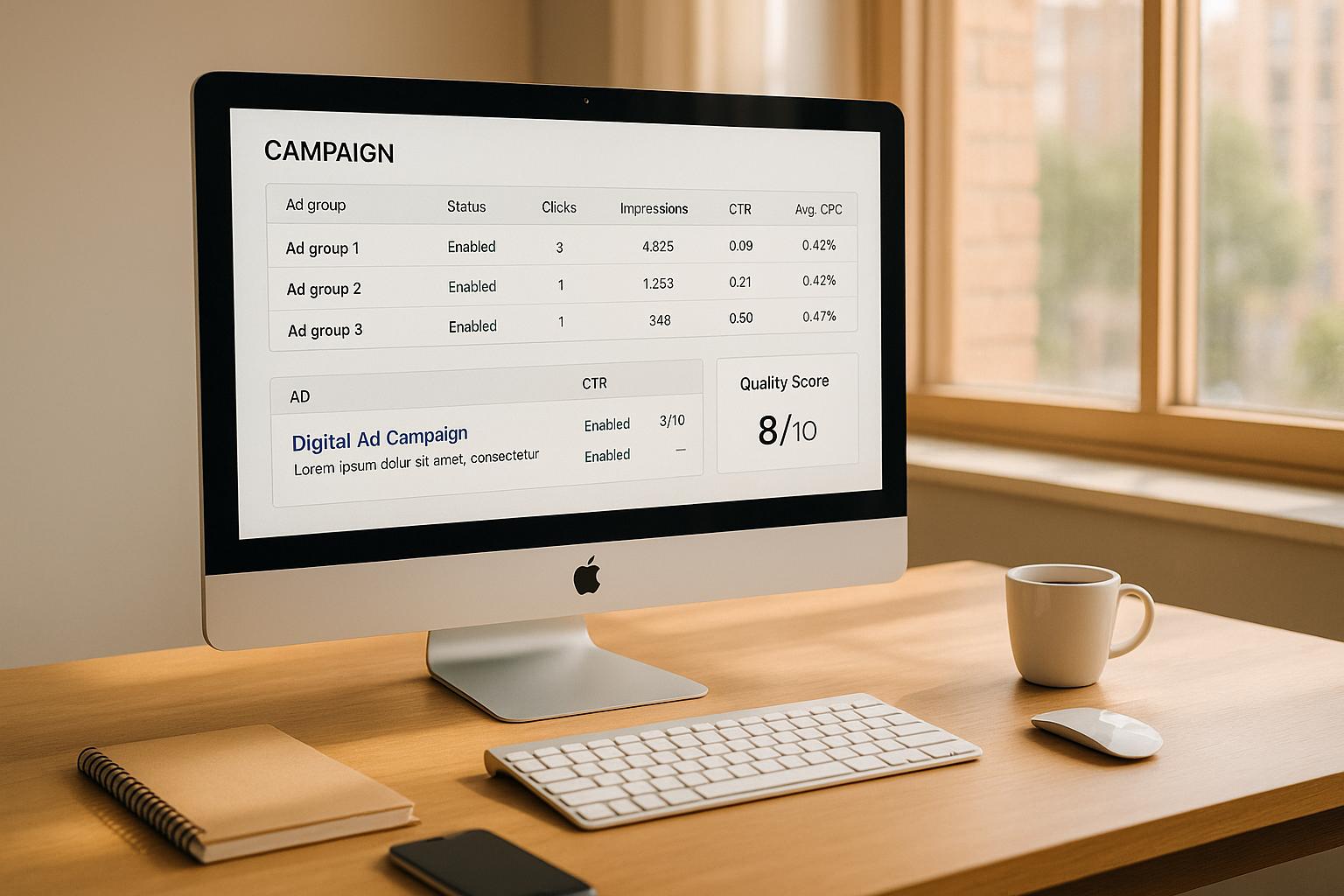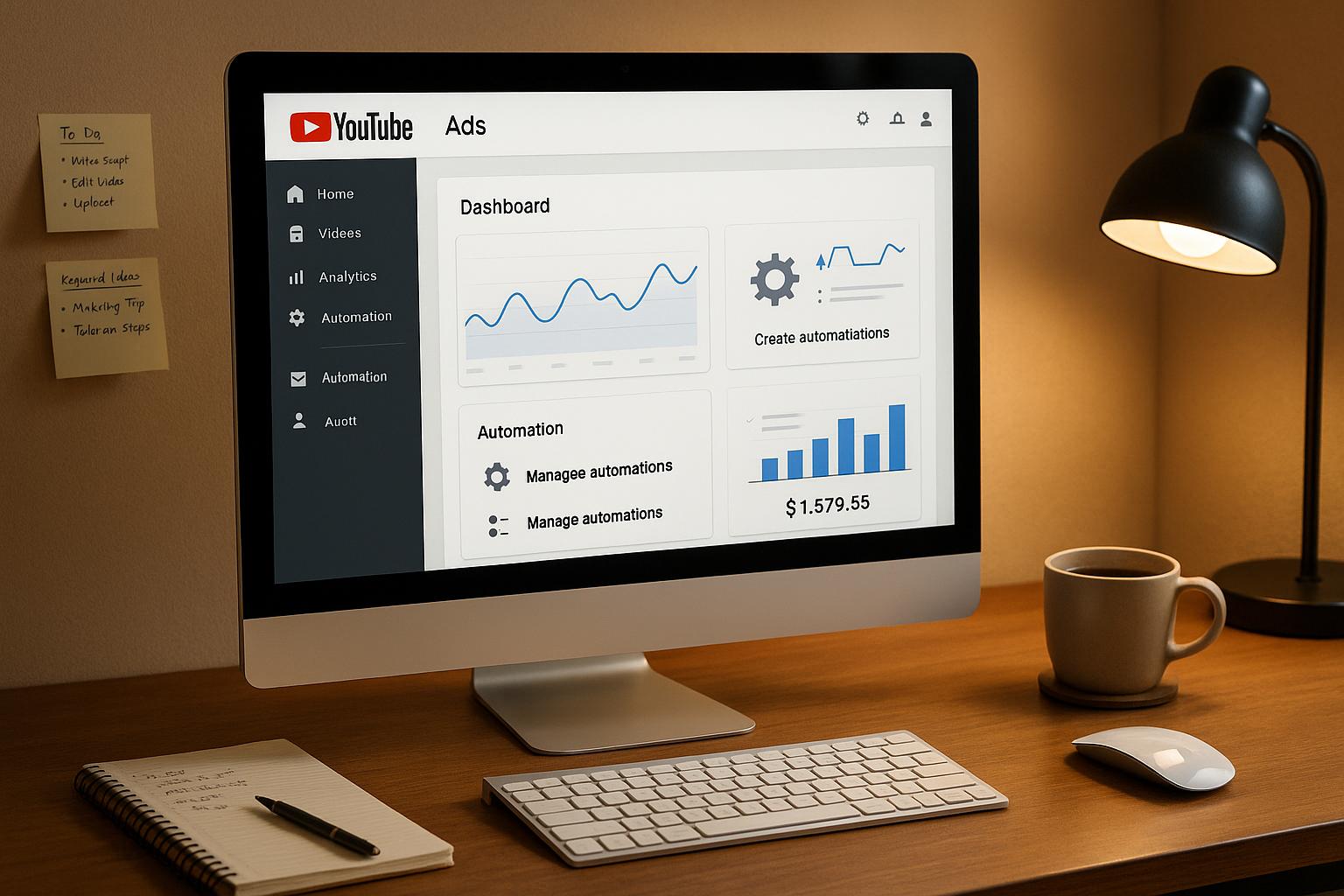Colors can influence emotions and actions, making them a critical factor in PPC (pay-per-click) success. Choosing the right color for your CTA (call-to-action) button can directly impact conversions. Here's what you need to know:
- Red: Creates urgency and encourages quick decisions, ideal for limited-time offers.
- Blue: Builds trust and reliability, great for finance or tech industries.
- Green: Represents growth and positivity, often used in wellness or eco-friendly campaigns.
- Orange: Combines urgency and energy, effective for promotions or new launches.
- Yellow: Conveys optimism and friendliness, works well for welcoming interactions.
The key is to align colors with your audience, industry, and brand identity while maintaining high contrast for visibility. A/B testing is essential to find what works best for your campaigns. Small tweaks, like changing button colors, can drive measurable improvements in PPC performance.
Are You Choosing the Right CTA Button Color for a Higher Conversion Rate?
How Common CTA Colors Affect User Behavior
Colors play a powerful role in shaping emotions, which in turn influence user actions. When it comes to PPC campaigns, understanding how specific colors impact behavior can help you choose the right CTA (call-to-action) hues to drive results.
Red: Urgency and Action
Red is known for creating a sense of urgency and excitement, making it one of the most effective colors for driving immediate action. Its eye-catching nature encourages quick decisions, which is why it’s often used for time-sensitive offers like flash sales or limited-time deals.
A well-known test revealed that red CTAs outperformed green ones by 21% in clicks. However, while red can be incredibly effective, it should be used carefully. Overusing it can overwhelm users or unintentionally signal danger, so balance is key.
Blue: Trust and Dependability
Blue is synonymous with trust, security, and professionalism. It’s a go-to choice for industries where reliability is paramount, such as finance, healthcare, and technology. Blue helps users feel safe and confident, which is especially important for actions like signing up, entering payment details, or downloading software. Its calming and dependable qualities can reduce hesitation and build trust.
Green: Growth and Positivity
Green is often linked to growth, health, and positivity. It’s also universally recognized as a "go" signal, making it a natural fit for CTAs that encourage users to move forward - like "Sign Up", "Start Free Trial", or "Continue."
This color works particularly well for campaigns tied to eco-friendly initiatives or wellness, reinforcing themes of health and progress. Its subtle encouragement can make users feel that taking the next step is the right choice.
Orange: Energy and Creativity
Orange combines the urgency of red with the warmth of yellow, creating a sense of confidence, creativity, and enthusiasm. This makes it a great choice for brands that want to appear approachable and energetic.
Orange is especially effective for campaigns promoting new product launches or special discounts, as it conveys excitement without feeling overly aggressive. A study by Ed Leake on 90 high-converting CTA buttons found that orange consistently ranks as one of the most effective colors for conversions.
Yellow: Optimism and Friendliness
Yellow radiates optimism and friendliness, making it ideal for CTAs that aim to create a welcoming and positive vibe. Its brightness naturally draws attention, but it’s important to pair it with high-contrast backgrounds to ensure readability, particularly for users with visual impairments. When used correctly, yellow can make CTAs feel inviting and approachable, encouraging interaction.
Understanding these color associations can help you choose the best CTA hues for your audience and industry, ensuring your campaigns resonate and drive action.
Choosing CTA Colors for Your Industry and Audience
Understanding color psychology is just the starting point; the real test is figuring out how to tailor this knowledge to your specific needs. There’s no one-size-fits-all answer when it comes to picking the perfect CTA color. The right choice depends heavily on your industry, audience, and the context of your brand. Let’s dive into how these factors shape your decisions.
Color Preferences by Industry
Each industry has its own set of color norms that customers expect and trust. For example, finance and SaaS companies often lean on blue. Why? Blue represents security and professionalism - critical traits when asking users to share sensitive details. It’s no surprise that many banks and financial platforms feature blue in their branding and CTAs to build trust.
Health and wellness brands, on the other hand, gravitate toward green. Green is tied to growth, healing, and positive outcomes, reinforcing the message of well-being these brands aim to convey. Meanwhile, in retail and e-commerce, red and orange dominate. These colors create urgency, making them perfect for sales and limited-time offers.
Tech companies frequently experiment with orange as well. Orange brings energy and creativity to the table. Brands like Amazon and HubSpot have used orange CTAs effectively - it feels approachable yet action-driven, striking a balance between urgency and friendliness.
Audience Demographics and Background Considerations
Your audience’s age, gender, and background play a big role in how they perceive colors. Younger audiences often respond well to vibrant shades like orange and red. These colors evoke excitement and encourage quick decisions.
In contrast, older audiences usually prefer softer tones like blue or green. These colors project stability and trust - qualities that tend to resonate more as people age. Gender can also influence color preferences, but it’s always smart to validate these assumptions through testing with your specific audience.
Cultural context is another key consideration, especially in the United States, where certain color associations are deeply ingrained. Red signals urgency and sales, green is tied to "go" and financial success, and blue conveys trust and professionalism. These associations align closely with the broader principles of color psychology discussed earlier.
Matching CTA Colors with Brand Identity
Your CTA color should not only align with your brand palette but also stand out enough to grab attention. Consistency in branding helps build recognition and trust - both of which directly impact conversions.
For example, a luxury brand might choose black or deep purple to communicate sophistication, while a wellness brand could stick with shades of green to emphasize growth and positivity. Whatever color you choose, make sure it contrasts sharply with its background to maximize visibility.
The key is to find a balance: the color should feel true to your brand while also delivering the emotional cues and visibility needed to drive action. Testing various options will help you pinpoint the sweet spot where brand identity and performance meet.
sbb-itb-89b8f36
A/B Testing Results and Case Studies
When it comes to CTA button colors, real-world A/B tests back up the theory: contrast and context are what drive PPC conversions - not just the color itself.
Key A/B Testing Results
In a 2011 experiment, HubSpot discovered that a red CTA button generated 21% more clicks than a green one. The takeaway? It wasn’t about red being “better”; it was about the red button creating a stronger contrast, making it more noticeable on the page.
Similarly, Ed Leake conducted a study analyzing 90 high-performing CTA buttons, finding that colors like orange, blue, red, and green were among the most effective. However, the results made one thing clear: there’s no universal “best” color. What works depends entirely on the campaign’s context and the audience.
Other industry-wide tests revealed that simply ensuring a CTA button stands out can boost sales by over 35%. And in a survey of 500 consumers, 39% said color was the most important visual element on a business’s website. These findings make it clear: refining CTA colors is a must for improving conversions.
Case Studies from Actual Campaigns
Big names like Amazon, Netflix, Mint Mobile, and Ahrefs have all seen major improvements by tweaking their CTA button colors through A/B testing. However, there’s no one-size-fits-all approach. For example, financial companies often succeed with blue buttons, which convey trust, while wellness brands lean toward green buttons, symbolizing growth and positivity.
These examples highlight why ongoing testing is essential for fine-tuning your CTA strategy.
Comparison Table of Test Results
| Study/Scenario | Comparison | Outcome | Key Insight |
|---|---|---|---|
| HubSpot (2011) | Red vs. Green button | +21% clicks | High contrast drives conversions |
| General Industry | High-contrast vs. Low-contrast CTAs | Up to +35% sales increase | Visibility is crucial |
| Time-Limited Offer | Green vs. Red button | +21% conversions | Urgency can amplify results |
| Ed Leake Study | Multiple CTA colors (Orange, Blue, Red, Green) | Mixed results across colors | Success depends on context and audience |
The pattern is clear: high-contrast buttons consistently perform better, but the best choice of color hinges on the specific audience and industry.
If you’re looking to dive into A/B testing and optimize your CTA colors, tools and services like those listed in the Top PPC Marketing Directory can help. Remember, there’s no magic formula - success comes from ongoing, data-driven experimentation.
Best Practices for CTA Color Optimization
Drawing from proven A/B testing insights, these strategies can help ensure your CTA button colors grab attention and drive conversions effectively.
Color Contrast and Accessibility Requirements
High contrast is key when designing CTA buttons. According to the Web Content Accessibility Guidelines (WCAG), the minimum contrast ratio should be 4.5:1 for normal text and 3:1 for larger text or graphical elements like buttons. Following these guidelines doesn’t just ensure compliance - it broadens your audience reach and enhances conversions.
For instance, a dark blue button on a light gray background or a bright orange button on white often meets these standards. When your CTA button visually pops against its background, it becomes impossible to overlook, which can directly boost click-through rates.
Don’t rely on color alone to communicate your message. Around 8% of men and 0.5% of women experience color blindness, which can make distinguishing certain combinations challenging. To accommodate all users, incorporate text labels, icons, or bold borders alongside color cues.
Tools such as color contrast checkers can help confirm your designs meet accessibility standards before launch. This proactive step not only avoids potential legal issues but also ensures you’re connecting with as many users as possible.
Once your CTA button meets accessibility standards, you can refine its appeal and performance through targeted A/B testing.
Using A/B Testing for Color Selection
When experimenting with CTA colors, focus on one variable at a time. Testing multiple changes simultaneously makes it difficult to pinpoint which adjustment influenced the outcome. For example, you might compare a green button to an orange one while keeping all other design elements consistent.
Allow enough time and gather sufficient data to ensure your results are statistically significant. User behavior can vary throughout the week or at different times of day, so rushing to conclusions based on limited data could undermine your efforts.
Keep detailed records of your findings. While a particular color might perform well in one campaign, it may not work as effectively in another. Over time, these insights can reveal patterns that guide your broader strategy. Documenting which colors resonate with specific audiences, industries, or campaign types can make future decisions easier.
Once you’ve established a reliable testing framework, consider using tools designed to streamline your optimization process.
Finding PPC Tools for Color Optimization
Specialized tools can simplify CTA color testing and provide actionable insights. A/B testing platforms are particularly useful for experimenting with different colors, while color contrast analyzers ensure your designs meet accessibility standards before going live.
Many campaign management tools come equipped with built-in testing features that integrate seamlessly into your existing PPC workflows. These tools can automatically rotate button colors, track performance metrics, and identify the most effective variations without requiring manual adjustments.
The Top PPC Marketing Directory is a helpful resource for discovering tools and agencies that specialize in CTA optimization. This platform allows businesses to compare solutions for A/B testing, campaign management, and performance tracking - key components for improving CTA effectiveness.
Experienced agencies listed in such directories can bring valuable expertise to your optimization efforts. They’re familiar with the nuances of color psychology, accessibility standards, and testing techniques, helping you achieve results more efficiently.
When choosing tools, prioritize those that offer in-depth analytics beyond basic metrics like click-through rates. Look for platforms that provide insights into user engagement, conversion paths, and long-term customer behavior to fully understand the impact of your color choices.
Additionally, consider integration capabilities. The best tools will work seamlessly with your existing PPC platforms, automatically applying successful color variations across campaigns without disrupting your workflow. This ensures a smoother, more efficient optimization process.
Conclusion
The psychology of color plays a crucial role in the success of PPC campaigns. Choosing the right CTA colors can spark emotions and significantly impact conversions. In fact, the difference between a struggling campaign and a thriving one often comes down to strategic color selection.
Colors like red and orange can create a sense of urgency, while blue fosters trust, and green symbolizes growth. However, these choices aren’t one-size-fits-all. Your audience’s preferences and industry standards should guide your decisions. For instance, financial sectors often lean toward blue for its trustworthy vibe, while wellness brands benefit from the calming and natural feel of green.
Demographics also matter. Younger audiences may respond better to bold, vibrant hues, while older users might prefer softer, more subdued tones. And let’s not overlook brand consistency - your CTA colors should complement your overall brand palette to strengthen recognition and trust.
A/B testing continues to be a game-changer in identifying what works best. There’s no universal "perfect" color for CTAs; instead, testing different options while maintaining high contrast and accessibility ensures your decisions are backed by data, not guesswork.
By prioritizing proper contrast ratios and accessibility standards, your CTAs can be both impactful and inclusive. The winning formula combines contrast-rich colors, brand alignment, and rigorous testing to drive results.
For those looking to take their campaigns to the next level, resources like the Top PPC Marketing Directory can connect you with tools and experts for A/B testing, campaign management, and performance tracking - key components for optimizing CTA effectiveness.
Ultimately, successful PPC color strategies hinge on understanding your audience, respecting industry norms, staying true to your brand, and making data-driven decisions. When these elements come together, the right CTA color becomes a powerful tool for boosting performance and driving growth.
FAQs
What’s the best way to choose a CTA button color that resonates with my audience and industry?
When choosing the best CTA button color for your audience and industry, it helps to start by understanding the emotions and meanings associated with various colors. For instance, blue is often linked to feelings of trust and dependability, while red can create a sense of urgency or excitement. Think about which color resonates most with your brand and the goals of your campaign.
From there, use A/B testing to experiment with different colors in your PPC campaigns. Pay close attention to performance metrics like click-through rates (CTR) and conversions to determine which color performs best. Remember, factors like audience preferences and cultural differences can influence results, so testing is essential for finding what works for your specific audience.
What mistakes should I avoid when selecting CTA colors using color psychology?
When selecting colors for your CTA buttons, there are a few missteps you’ll want to steer clear of to keep your campaign on track:
- Straying from your brand identity: Using colors that clash with your brand’s established look can confuse visitors and dilute your messaging. Consistency is key.
- Going overboard with contrasts: Too many clashing colors can overwhelm the page and pull attention away from the CTA’s main purpose.
- Letting personal taste take over: Picking colors based on your own preferences instead of considering what resonates with your audience can hurt your results.
Instead, try experimenting with different color options and track how they perform. Analyzing these metrics will help you find the best fit for your audience and campaign objectives.
How does color contrast influence the visibility and performance of CTA buttons in PPC campaigns?
Color contrast is a key factor in making CTA (Call-to-Action) buttons noticeable and effective in PPC campaigns. A strong contrast between the button color and its background ensures the CTA grabs attention, guiding users to click. For instance, using a bright color like orange or green for the button against a neutral background can create a striking visual effect.
Beyond aesthetics, proper color contrast enhances accessibility for users with visual impairments. This means your campaigns can engage a wider audience. By adhering to the Web Content Accessibility Guidelines (WCAG) for contrast ratios, you can design CTAs that are not only inclusive but also optimized for better performance and higher conversions.


